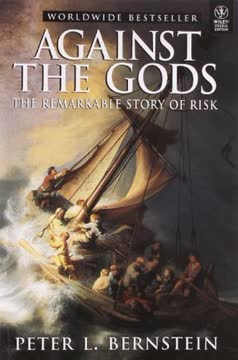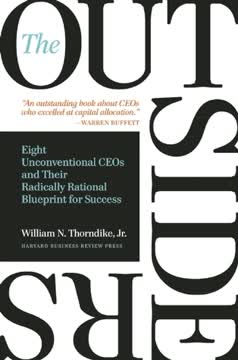نکات کلیدی
1. اثر هاله: ادراکات رنگآمیزی شده توسط عملکرد
اثر هاله یک سوگیری شناختی است که بهطور قابل توجهی بر نحوهی ادراک ما از شرکتهای موفق تأثیر میگذارد. زمانی که یک شرکت از نظر مالی عملکرد خوبی دارد، ما تمایل داریم ویژگیهای مثبت را به جنبههای مختلف سازمان نسبت دهیم، مانند:
- رهبری: مدیران بهعنوان افرادی بصیر و کاریزماتیک دیده میشوند
- فرهنگ: شرکت بهعنوان دارای فرهنگی قوی و مثبت درک میشود
- استراتژی: تصمیمات تجاری بهعنوان درخشان و بهخوبی اجرا شده تلقی میشوند
- تمرکز بر مشتری: سازمان بهعنوان بسیار حساس به نیازهای مشتریان تصور میشود
برعکس، زمانی که عملکرد کاهش مییابد، این ویژگیها معمولاً بهطور منفی دیده میشوند. این اثر شناسایی دقیق عوامل واقعی موفقیت یا شکست را دشوار میسازد.
2. همبستگی در مقابل علیت: یک تمایز حیاتی
اشتباه گرفتن همبستگی با علیت یک دام رایج در تحلیلهای تجاری است. بسیاری از مطالعات همبستگیهایی بین برخی شیوهها و عملکرد شرکتها نشان میدهند، اما قادر به اثبات علیت نیستند. نکات کلیدی:
- توالی زمانی: آیا این شیوه قبل از بهبود عملکرد رخ داده است؟
- توضیحات جایگزین: آیا عوامل دیگری میتوانند مسئول اثر مشاهده شده باشند؟
- علیت معکوس: آیا ممکن است عملکرد خوب به پذیرش برخی شیوهها کمک کند، نه برعکس؟
برای جلوگیری از این توهم، مدیران باید:
- به دنبال شواهدی از مکانیسمهای علی باشند
- چندین توضیح برای همبستگیهای مشاهده شده را در نظر بگیرند
- به ادعاهای ساده علت و معلولی در محیطهای تجاری پیچیده شک کنند
3. توهم توضیحات واحد در موفقیت تجاری
تعامل پیچیده عوامل به موفقیت تجاری کمک میکند، نه عناصر واحد و جداگانه. بسیاری از کتابها و مطالعات تجاری محبوب در دام سادهسازی میافتند و بر یک عامل خاص تمرکز میکنند، مانند:
- سبک رهبری
- فرهنگ شرکتی
- شیوههای نوآوری
- گرایش به مشتری
در واقع، این عوامل معمولاً بههم پیوسته و تقویتکننده یکدیگر هستند. یک رویکرد دقیقتر به این نکته توجه دارد که:
- عوامل متعددی بهطور همزمان به موفقیت کمک میکنند
- اهمیت نسبی عوامل ممکن است بسته به صنعت، اندازه شرکت و شرایط بازار متفاوت باشد
- موفقیت اغلب نتیجه همافزایی بین عناصر مختلف است، نه اثرات فردی آنها
4. افسانه موفقیت پایدار و عظمت ماندگار
عملکرد پایدار بالا در دنیای تجارت بسیار نادر است. نکات کلیدی:
- بیشتر شرکتها دورههای موفقیت را تجربه میکنند که با کاهش همراه است
- از 1435 شرکتی که در طول 40 سال مطالعه شدهاند، تنها 74 شرکت در S&P 500 باقی ماندند و تنها 12 شرکت از بازار پیشی گرفتند
- شرکتهای "ساخته شده برای ماندن" معمولاً پس از شناسایی بهعنوان شرکتهای بزرگ، عملکرد ضعیفی دارند
دلایل این الگو:
- فشارهای رقابتی به مرور زمان مزیتها را از بین میبرد
- فناوریهای مخرب میتوانند بازیگران established را دچار اختلال کنند
- شرایط بازار و ترجیحات مصرفکننده تغییر میکند
- موفقیت میتواند به راحتطلبی یا مقاومت در برابر تغییر منجر شود
مدیران باید بر سازگاری و بهبود مستمر تمرکز کنند، نه اینکه به دنبال فرمولی برای موفقیت دائمی باشند.
5. عملکرد نسبی: موفقیت در یک چشمانداز رقابتی
عملکرد شرکت نسبی است، نه مطلق. یک شرکت میتواند بهبود یابد و در عین حال عقبتر بیفتد.
موفقیت بهطور ذاتی نسبی در دنیای تجارت است. نکات کلیدی:
- بهبود در شرایط مطلق تضمینکننده موفقیت نیست اگر رقبا سریعتر بهبود یابند
- سهم بازار و سودآوری به عملکرد نسبت به رقبا بستگی دارد
- صنایع در حال تحول هستند و استانداردهای عملکرد خوب را بالا میبرند
مثال: کیمارت بسیاری از جنبههای عملیات خود را بهبود بخشید اما همچنان از والمارت و تارگت عقب ماند و در نهایت به ورشکستگی رسید.
پیامدها برای مدیران:
- بهطور مداوم با رقبا مقایسه کنید
- بر ایجاد مزیتهای رقابتی پایدار تمرکز کنید
- روندهای صنعتی و انتظارات در حال تحول مشتریان را پیشبینی کنید
6. خطر نسبت دادن موفقیت به عوامل خاص
خطر منطق معکوس در تحلیلهای تجاری رایج است. بسیاری از مطالعات ویژگیهای مشترک بین شرکتهای موفق را شناسایی کرده و بهطور نادرست نتیجهگیری میکنند که این ویژگیها باعث موفقیت هستند. این "توهم اتصال نقاط برنده" نادیده میگیرد:
- سوگیری بقای: ما فقط شرکتهای موفق را میبینیم، نه شکستها
- سوگیری انتخاب: انتخاب شرکتها بر اساس نتایج، نتایج را تحریف میکند
- عدم مقایسه: عدم بررسی شرکتهای کمتر موفق با ویژگیهای مشابه
یک رویکرد دقیقتر باید:
- دامنه وسیعی از شرکتها، از جمله شکستها را مطالعه کند
- بررسی کند که چقدر ویژگیهای خاص منجر به موفقیت یا شکست میشوند
- زمینه و زمان تصمیمات استراتژیک را در نظر بگیرد
7. استراتژی و اجرا: دو رکن عملکرد
استراتژی و اجرا هستهی عملکرد تجاری را تشکیل میدهند. جنبههای کلیدی:
استراتژی:
- انتخاب بازارهایی که در آنها رقابت میکنید
- تصمیمگیری در مورد پیشنهادات محصول/خدمات
- موقعیتیابی نسبت به رقبا
اجرا:
- اجرای مؤثر استراتژیهای انتخاب شده
- مدیریت عملیات روزمره
- بهبود مستمر فرآیندها و قابلیتها
هر دو عنصر شامل عدم قطعیت و ریسک هستند. شرکتهای موفق در:
- اتخاذ تصمیمات استراتژیک آگاهانه بر اساس تحلیل بازار
- سازگاری با تغییر شرایط
- اجرای استراتژیها با انضباط و انعطافپذیری
- اندازهگیری و بهبود مستمر اجرا
8. پذیرش عدم قطعیت: واقعیت تصمیمگیری تجاری
عدم قطعیت ذاتی در تصمیمگیری تجاری وجود دارد. نکات کلیدی:
- هیچ استراتژی یا برنامه اجرایی موفقیت را تضمین نمیکند
- عوامل خارجی (تغییرات بازار، اقدامات رقبا، تغییرات فناوری) عدم پیشبینی را به وجود میآورند
- قابلیتها و محدودیتهای داخلی پیچیدگی را اضافه میکند
مدیران مؤثر:
- اطلاعات مرتبط را جمعآوری و تحلیل میکنند
- چندین سناریو و نتایج بالقوه را در نظر میگیرند
- ریسکهای محاسبه شده را بر اساس احتمالات، نه قطعیتها، اتخاذ میکنند
- انعطافپذیر باقی میمانند و با ظهور اطلاعات جدید سازگار میشوند
- از هر دو موفقیت و شکست درس میگیرند
9. محدودیتهای فرمولها و "قوانین" تجاری
هر کسی که ادعا کند قوانین فیزیک تجارت را یافته است، یا در مورد تجارت کم میداند، یا در مورد فیزیک، یا هر دو.
از فرمولهای ساده برای موفقیت تجاری بپرهیزید. بر خلاف فیزیک، تجارت بر اساس قوانین غیرقابل تغییر عمل نمیکند. دلایل کلیدی:
- رفتار انسانی عدم پیشبینی را به وجود میآورد
- شرایط بازار بهطور مداوم در حال تحول است
- تعاملات پیچیده بین چندین متغیر
- زمینههای منحصر به فرد برای هر شرکت و صنعت
بهجای جستجوی قوانین جهانی، مدیران باید:
- مهارتهای تفکر انتقادی را توسعه دهند
- هر وضعیت را در زمینه خاص خود تحلیل کنند
- از تجربیات گذشته بیاموزند اما از کاربرد کورکورانه "قوانین" پرهیز کنند
- به ایدهها و رویکردهای جدید باز باشند
10. تفکر انتقادی: ضروری برای مدیریت خردمندانه
توسعه مهارتهای تفکر انتقادی برای مدیریت مؤثر بسیار مهم است. جنبههای کلیدی:
- پرسش از فرضیات و حکمتهای متعارف
- ارزیابی شواهد و ادعاها بهطور دقیق
- در نظر گرفتن توضیحات و دیدگاههای جایگزین
- شناسایی سوگیریهای شناختی و مغالطات منطقی
گامهای عملی برای مدیران:
- به دنبال منابع اطلاعاتی و دیدگاههای متنوع باشید
- بحثهای سازنده را تشویق کنید و درون تیمها چالش ایجاد کنید
- بهطور منظم مدلهای ذهنی و باورهای خود را مرور و بهروزرسانی کنید
- پیچیدگی و ظرافت را در تحلیلهای تجاری بپذیرید
- تواضع فکری و باز بودن به ایدههای جدید را پرورش دهید
با توسعه این مهارتها، مدیران میتوانند در چشمانداز پیچیده تجاری بهطور مؤثرتری حرکت کنند و تصمیمات بهتری اتخاذ کنند.
آخرین بهروزرسانی::
FAQ
What's The Halo Effect about?
- Explores business delusions: The Halo Effect by Philip M. Rosenzweig examines common misconceptions in business management, focusing on how the Halo Effect leads to misattributions about company performance.
- Questions success and failure: It delves into why some companies succeed while others fail, highlighting that many perceived success drivers are often just attributions based on prior performance.
- Encourages critical thinking: The book urges managers to think critically and independently, challenging popular business narratives and expert advice.
Why should I read The Halo Effect?
- Challenge conventional wisdom: The book offers a fresh perspective on business success, encouraging readers to question widely accepted management beliefs and practices.
- Improve decision-making: By understanding the delusions that cloud judgment, readers can make more informed and rational decisions in their organizations.
- Real-world examples: It uses case studies from companies like Cisco and ABB to illustrate the pitfalls of misattributing success and failure.
What are the key takeaways of The Halo Effect?
- Beware of the Halo Effect: Many attributions about company performance are influenced by prior success, leading to flawed conclusions about what drives that success.
- Correlation vs. causation: The book stresses the importance of distinguishing between correlation and causation, as many studies fail to do so, leading to misleading interpretations.
- Delusions in business thinking: It identifies several delusions, such as the Delusion of Single Explanations and the Delusion of Lasting Success, which can hinder effective management.
What is the Halo Effect as defined in The Halo Effect?
- General impression influences specifics: The Halo Effect refers to the tendency to make inferences about specific traits based on an overall impression, such as assuming a company with good financial performance also has a strong culture.
- Cognitive bias: This bias simplifies complex evaluations, making it difficult to assess individual attributes independently.
- Impact on business decisions: It can lead managers to misattribute success to factors like leadership or culture, rather than recognizing the role of external circumstances or market conditions.
How does The Halo Effect critique popular business books?
- Flawed research methods: The book argues that many popular business books rely on anecdotal evidence and flawed research methods susceptible to the Halo Effect.
- Overgeneralization of success factors: These books often present a narrow view of what leads to success, ignoring the complexity and variability of business environments.
- Encourages critical analysis: The critique serves as a call for readers to approach such books with skepticism and seek a deeper understanding of performance factors.
What are some examples of companies discussed in The Halo Effect?
- Cisco Systems: The book discusses Cisco's rise and fall, illustrating how its initial success led to overconfidence and misattributions about its customer focus and management practices.
- ABB: ABB is used as a case study to show how perceptions of success can change dramatically based on performance, highlighting the role of leadership and corporate culture.
- Lego: The author examines Lego's struggles, emphasizing how the narrative around its performance shifted based on its financial results, demonstrating the Halo Effect in action.
What is the Delusion of Correlation and Causality in The Halo Effect?
- Misinterpretation of data: This delusion refers to the common mistake of assuming that correlation between two variables implies causation without sufficient evidence.
- Example of employee satisfaction: The book discusses how studies often show a correlation between employee satisfaction and company performance, but it may be that high performance leads to greater satisfaction instead.
- Need for rigorous research: The author stresses the importance of conducting research that can accurately determine causality rather than relying on superficial correlations.
How does The Halo Effect address the Delusion of Lasting Success?
- Temporary nature of success: The book argues that many companies that appear successful over time often experience declines, challenging the notion of enduring greatness.
- Historical examples: It cites studies showing that a significant percentage of companies that were once leaders have fallen from grace, illustrating business success volatility.
- Encourages humility: The author suggests that managers should remain humble and recognize that success can be fleeting, rather than assuming past performance guarantees future results.
What is the "4+2 Formula" mentioned in The Halo Effect?
- Definition of the formula: The "4+2 Formula" identifies four primary practices (strategy, execution, culture, and structure) and two additional practices (talent and leadership) that correlate with business success.
- Critique of the formula: The author argues that while these practices may be associated with high performance, they do not guarantee success, as context and competitive environment play crucial roles.
- Caution against oversimplification: The book warns against viewing this formula as a blueprint for success, emphasizing that performance is influenced by multiple factors.
What are the best quotes from The Halo Effect and what do they mean?
- “The central idea in this book is that our thinking about business is shaped by a number of delusions.” This quote encapsulates the book's premise that misconceptions can cloud judgment and decision-making in business.
- “Success in business is as elusive as ever.” This highlights the complexity of achieving and maintaining success in a rapidly changing business environment, emphasizing that there are no simple formulas.
- “If you think your strategy is foolproof, the fool may well be you.” This serves as a caution against overconfidence in strategic decisions, urging managers to remain aware of inherent risks.
How can I apply the lessons from The Halo Effect in my own business?
- Critical evaluation of performance: Regularly assess your company's performance metrics without letting past successes cloud your judgment about current practices and strategies.
- Avoid simplistic explanations: When analyzing what drives your company's success, consider multiple factors and avoid attributing performance to a single cause or leader.
- Foster a culture of inquiry: Encourage open discussions and critical thinking among your team to challenge assumptions and explore the complexities of your business environment.
How does the book address the concept of strategic choice?
- Risky nature of strategic choices: The book discusses how strategic decisions involve significant risks, as they are based on predictions about customer behavior, competitor actions, and technological changes.
- Importance of context: It emphasizes that the effectiveness of a strategy is not only determined by its design but also by the competitive landscape and market conditions.
- Need for adaptability: The author advocates for a flexible approach to strategy, encouraging managers to be prepared to pivot in response to changing circumstances.
نقد و بررسی
کتاب اثر هالهای به چالش کشیدن باورهای رایج در دنیای کسبوکار میپردازد و استدلال میکند که موفقیت را نمیتوان به فرمولهای ساده تقلیل داد. روزنزوایگ به نقد کتابهای پرفروش مدیریت میپردازد و نواقص روشهای تحقیق و نتایج آنها را آشکار میسازد. او بر پیچیدگی موفقیت در کسبوکار تأکید میکند و نقشهای استراتژی، اجرا و شانس را مورد توجه قرار میدهد. خوانندگان از رویکرد انتقادی این کتاب قدردانی میکنند و بینشهای آن در مورد سوگیریهای شناختی و محدودیتهای تحلیلهای بازگشتی در درک عملکرد شرکتها را ستایش میکنند. بسیاری این کتاب را برای مدیران و دانشجویان کسبوکار ضروری میدانند و آن را به عنوان نگاهی تازه به موفقیت سازمانی معرفی میکنند.
Similar Books













